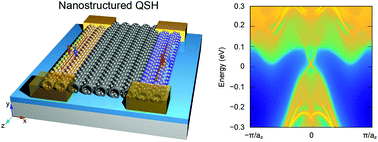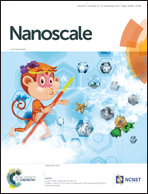Nanostructured topological state in bismuth nanotube arrays: inverting bonding–antibonding levels of molecular orbitals†
Abstract
We demonstrate a new class of nanostructured topological materials that exhibit a topological quantum phase arising from nanoscale structural motifs. Based on first-principles calculations, we show that an array of bismuth nanotubes (Bi-NTs), a superlattice of Bi-NTs with periodicity in the order of tube diameter, behaves as a nanostructured two-dimensional (2D) quantum spin Hall (QSH) insulator, as confirmed from the calculated band topology and 1D helical edge states. The underpinning mechanism of the QSH phase in the Bi-NT array is revealed to be inversion of bonding–antibonding levels of molecular orbitals of constituent nanostructural elements in place of atomic-orbital band inversion in conventional QSH insulators. The quantized edge conductance of the QSH phase in a Bi-NT array can be more easily isolated from bulk contributions and their properties can be highly tuned by tube size, representing distinctive advantages of nanostructured topological phases. Our finding opens a new avenue for topological materials by extending topological phases into nanomaterials with molecular-orbital-band inversion.



 Please wait while we load your content...
Please wait while we load your content...